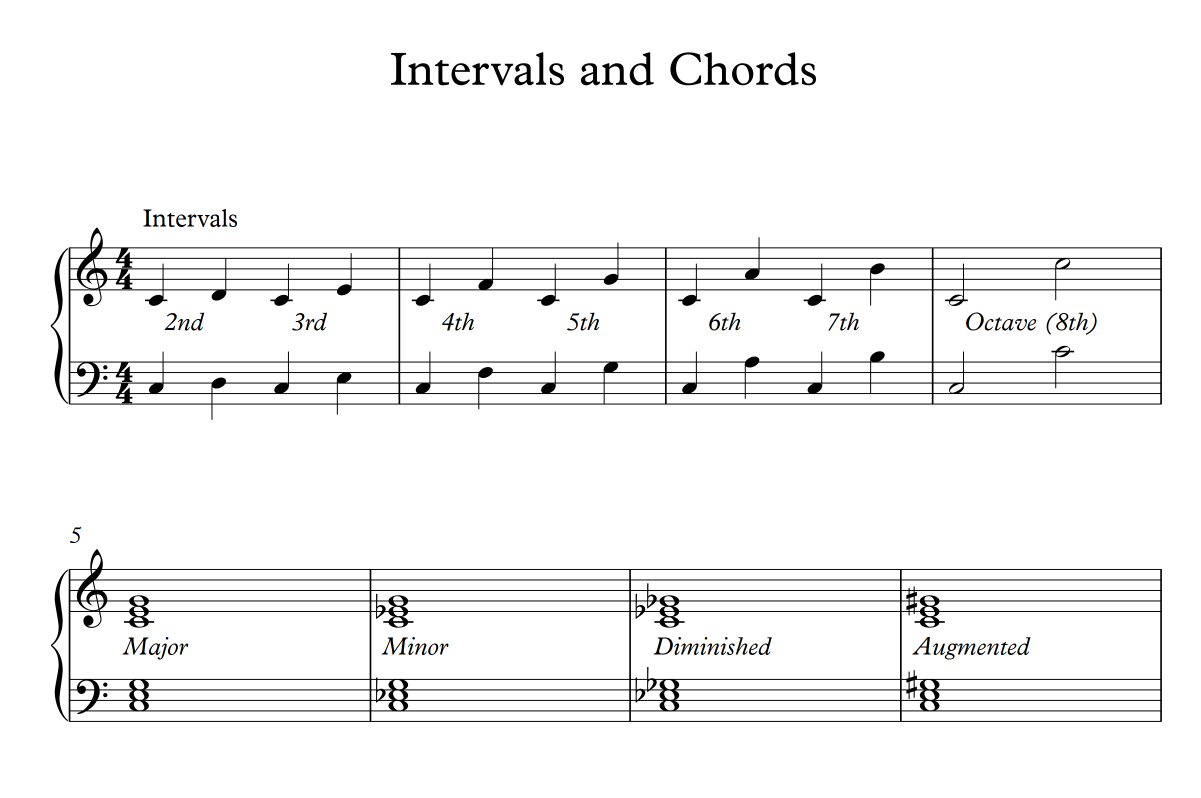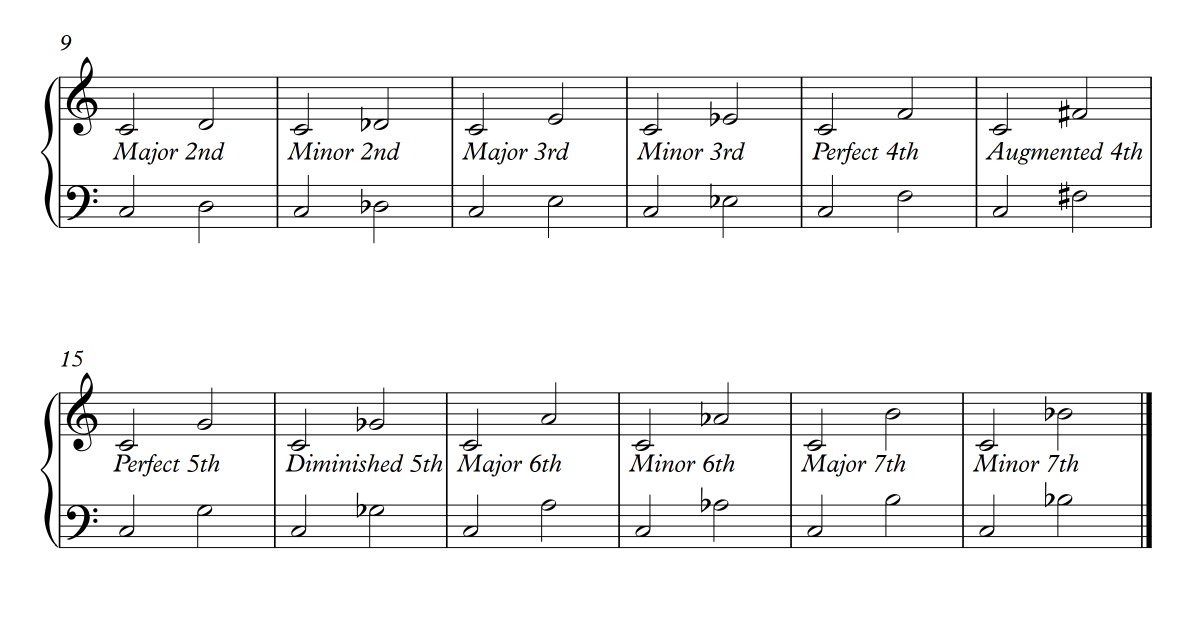Introduction to Music
for those wanting to become musicans, or improve their musicianship
Chords and Intervals
Intervals
An interval is the distance between two notes. We describe intervals in numerical terms, 2nd, 3rd, 4th, etc. From the note C to the note D is a 2nd. Although D is only one note away from C, we call it a second because two notes are involved. Think of intervals in terms of letter names. If you are on a G and the next note is a D higher, you have G, A, B, C then D, 5 letters. Thus, G up to D is an interval of a 5th. You can have major or minor 2, 3, 6 & 7ths. You can have perfect, augemented or diminished 4, 5 and octaves. More about these differences later.
We usually only count intervals from a 2nd to 8th. The 8th is called an octave. Once you get higher than an octave it is common to say ‘an octave and’ whatever the interval is. That being said, you will hear about 9th, 10th, 11th, 12th and even 13th, particularly when talking about chord extensions. But you rarely, if ever, will see intervals beyond 13ths used.
Why intervals? When reading music, it is often easier to read intervals than specific note names, especially if you are trying to read multiple notes, as in keyboard music or chords. For example, on piano, rather than try to figure out the note name on the music staff then figure out where you play it, you can quickly figure out the interval, then play the finger that many intervals higher. So, if your thumb is playing a G and the next note is a 5th higher, just play your 5th finger. I would say most experienced musicians read music more by intervals than by reading actual note letter names.
Chords
(See the graphic at the top of the article for examples of chords). The basic definition of a chord is this: “Three notes or more, when played at the same time is a chord.” In the majority of the most popular music in the world, most chords consists of triads. For our purposes, we will only be talking about triads. That is, the notes in the chord are made up of intervals of thirds. A C major chord, for example, consists of the notes C, E and G, all intervals of 3rds.
To properly spell a chord (triad), each letter of the chord must be an interval of a third. For example, a C# major chord is C#, E#, G#. Although E# is the same note as F, it is not considered proper to spell the C# major chord with an F, it must be an E#. The reason being that from C to E (with or without a sharp) is a third. From C to F is a 4th. If you ever wondered why we have double sharps or double flats, this is one reason why. For example, a D# major chord is spelled D#, F-double-sharp, A#. A G-flat major chord is spelled Gb, B-double-flat, Db.
The four types of chords are major, minor, diminished and augmented chords. (Yes, there are ‘suspended’ chords but they aren’t triads). What’s the difference? This is where chords and intervals come together.
A major chord consists of 4 half-steps, which is also called a Major 3rd, between the lowest note (called the root) and the middle note. A Minor chord has three half-steps, also called a Minor-third, from the root to the middle note. From the lowest note to the top note in Major and Minor chords is always 7 half-steps which is better known as a Perfect 5th.
We haven’t talked about scales yet, but another way to think of chords would be using scales. For now, suffice it to say that a C major scale consists of all the letter names (without accidentals) from C to the next highest C: C D E F G A B C. If we assign numbers to each letter, the 1st, 3rd, and 5th notes of the scale, the C,E & G make up the C major chord. We call the notes of the chord the root, 3rd & 5th (from bottom to top).
An augmented chord consists of a Major 3 from the root to the 3rd and an Augmented 5th from the bottom to the top note. An augmented 5th is 8 half-steps.
A diminished chord consists of a Minor 3 from the root to the 3rd and a Diminished 5th from the bottom to the top note. A diminished 5th is only 6 half steps.
A chord has to be 3 notes at a minimum, but there is nothing that says it can only be 3 notes. We can have chords with 7 notes. To add a 4th note, you guessed it, we add a note a 3rd higher. In a C chord, we would add a B. Then we could add a D, F, etc. I cover this and more about chords in my YouTube series.
For more on chords, see my YouTube series on the subject (shown below)
Next time: Scales and modes
[youtube http://www.youtube.com/watch?v=VmezVWK0Ex8?hl=en&fs=1&w=425&h=349]



10 replies on “Introduction to Music, Part 9 (Intervals & Chords)”
[…] Introduction to Music, Part 9 (Intervals & Chords) (jamesgilbertmusic.wordpress.com) […]
[…] Introduction to Music, Part 9 (Intervals & Chords) (jamesgilbertmusic.wordpress.com) […]
[…] Power Chords for Acoustic and Electric Guitar PlayersMAJOR 7 ChordsIntroduction to Music, Part 9 (Intervals & Chords) […]
[…] Introduction to Music, Part 9 (Intervals & Chords) (jamesgilbertmusic.wordpress.com) […]
[…] Introduction to Music, Part 9 (Intervals & Chords) (jamesgilbertmusic.wordpress.com) […]
Wow, incredible blog layout! How long have you been blogging for? you made blogging look easy. The overall look of your web site is magnificent, let alone the content!. Thanks For Your article about Introduction to Music, Part 9 (Intervals & Chords) | jamesgilbertmusic .
Hi! I just wanted to ask if you ever have any trouble with hackers?
My last blog (wordpress) was hacked and I ended up losing many months of hard
work due to no backup. Do you have any methods to protect
against hackers?
No, but I do have problems with people trying to post bogus comments that include links to spam websites. I usually delete those, but sometimes I edit out the links and reply like this. Anyone have any real questions about intervals & chords? Glad to answer those.
Do you mind if I quote a few of your articles as long as I provide credit and sources
back to your website? My blog is in the very same area of interest as yours
and my visitors would really benefit from a lot of the information you provide here.
Please let me know if this okay with you. Cheers!
That would be fine.